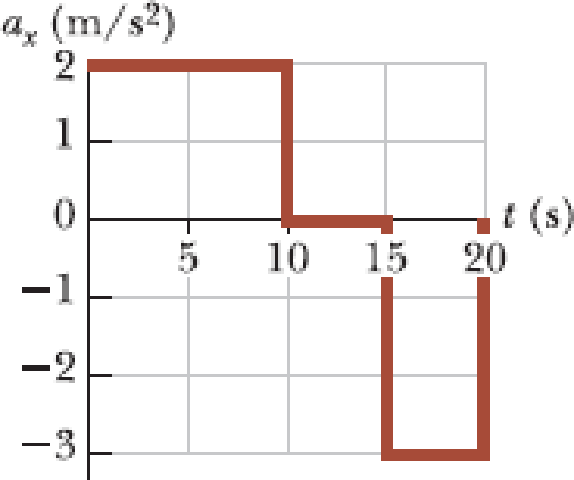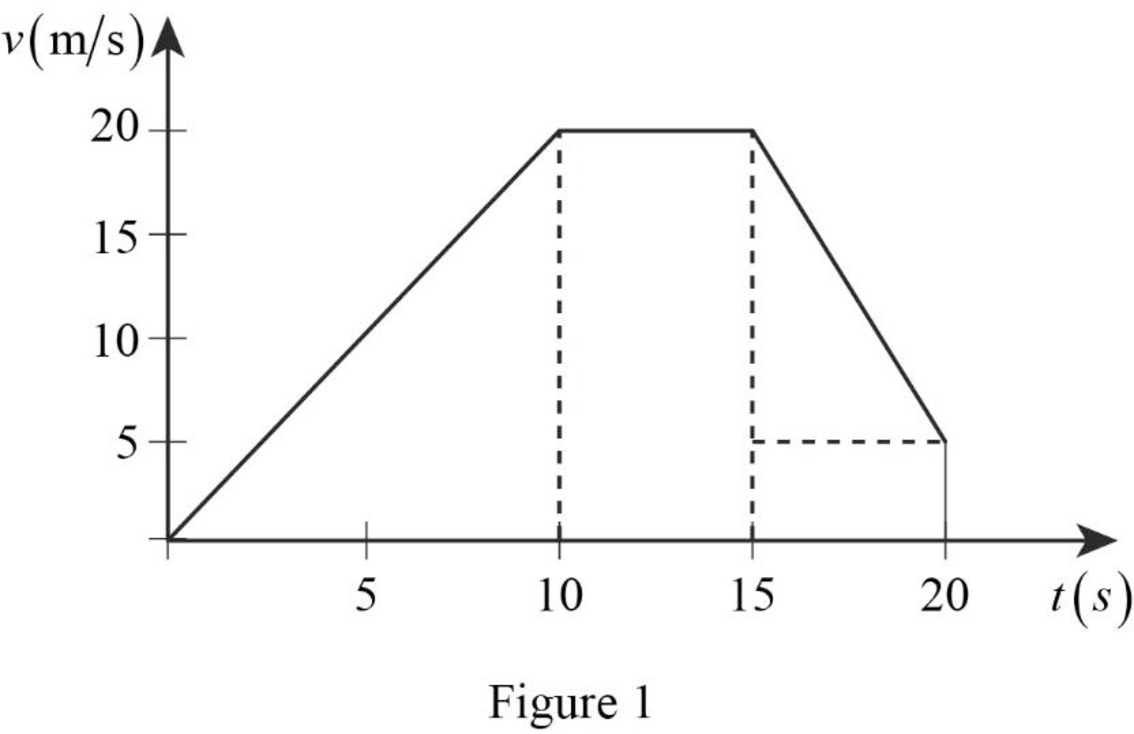
Concept explainers
A particle starts from rest and accelerates as shown in Figure P2.13. Determine (a) the particle’s speed at t = 10.0 s and at t = 20.0 s, and (b) the distance traveled in the first 20.0 s.

(a)
The particle’s speed at
Answer to Problem 13P
The particle’s speed at
Explanation of Solution
Write the equation for the final velocity of a particle.
Here,
The area under acceleration versus time graph under specific time intervals gives the change in velocity of the particle during the time interval. Speed is the magnitude of velocity.
The sides of a unit rectangle in the graph are
The area under the graph in the interval
Since the particle starts from rest, its velocity at
Substitute
The area under the graph in the interval
Substitute
Conclusion:
Therefore, the particle’s speed at
(b)
The distance travelled in the first
Answer to Problem 13P
The distance travelled in the first
Explanation of Solution
The area under velocity versus time graph under specific time intervals gives the displacements during the time interval.
In part (a), it is found that the velocity at
The velocity versus time graph is shown below.

The area from
Write the equation for the area of a triangle.
Here,
In figure 1, the base of the triangle from
Substitute
Here,
The area from
Write the equation for the area of a rectangle.
Here,
In figure 1, the length of the rectangle from
Substitute
Here,
The area from
In figure 1, the base of the triangle from
Substitute
Here,
In figure 1, the length of the rectangle from
Substitute
Here,
Write the equation for total distance travelled.
Here,
Conclusion:
Substitute
Therefore, the distance travelled in the first
Want to see more full solutions like this?
Chapter 2 Solutions
Bundle: Principles of Physics: A Calculus-Based Text, 5th + WebAssign Printed Access Card for Serway/Jewett's Principles of Physics: A Calculus-Based Text, 5th Edition, Multi-Term
- Hi! I need help with these calculations for part i and part k for a physics Diffraction Lab. We used a slit width 0.4 mm to measure our pattern.arrow_forwardExamine the data and % error values in Data Table 3 where the angular displacement of the simple pendulum decreased but the mass of the pendulum bob and the length of the pendulum remained constant. Describe whether or not your data shows that the period of the pendulum depends on the angular displacement of the pendulum bob, to within a reasonable percent error.arrow_forwardIn addition to the anyalysis of the graph, show mathematically that the slope of that line is 2π/√g . Using the slope of your line calculate the value of g and compare it to 9.8.arrow_forward
- An object is placed 24.1 cm to the left of a diverging lens (f = -6.51 cm). A concave mirror (f= 14.8 cm) is placed 30.2 cm to the right of the lens to form an image of the first image formed by the lens. Find the final image distance, measured relative to the mirror. (b) Is the final image real or virtual? (c) Is the final image upright or inverted with respect to the original object?arrow_forwardConcept Simulation 26.4 provides the option of exploring the ray diagram that applies to this problem. The distance between an object and its image formed by a diverging lens is 5.90 cm. The focal length of the lens is -2.60 cm. Find (a) the image distance and (b) the object distance.arrow_forwardPls help ASAParrow_forward
 Principles of Physics: A Calculus-Based TextPhysicsISBN:9781133104261Author:Raymond A. Serway, John W. JewettPublisher:Cengage Learning
Principles of Physics: A Calculus-Based TextPhysicsISBN:9781133104261Author:Raymond A. Serway, John W. JewettPublisher:Cengage Learning Physics for Scientists and Engineers with Modern ...PhysicsISBN:9781337553292Author:Raymond A. Serway, John W. JewettPublisher:Cengage Learning
Physics for Scientists and Engineers with Modern ...PhysicsISBN:9781337553292Author:Raymond A. Serway, John W. JewettPublisher:Cengage Learning College PhysicsPhysicsISBN:9781285737027Author:Raymond A. Serway, Chris VuillePublisher:Cengage Learning
College PhysicsPhysicsISBN:9781285737027Author:Raymond A. Serway, Chris VuillePublisher:Cengage Learning Physics for Scientists and Engineers, Technology ...PhysicsISBN:9781305116399Author:Raymond A. Serway, John W. JewettPublisher:Cengage Learning
Physics for Scientists and Engineers, Technology ...PhysicsISBN:9781305116399Author:Raymond A. Serway, John W. JewettPublisher:Cengage Learning Physics for Scientists and Engineers: Foundations...PhysicsISBN:9781133939146Author:Katz, Debora M.Publisher:Cengage Learning
Physics for Scientists and Engineers: Foundations...PhysicsISBN:9781133939146Author:Katz, Debora M.Publisher:Cengage Learning College PhysicsPhysicsISBN:9781938168000Author:Paul Peter Urone, Roger HinrichsPublisher:OpenStax College
College PhysicsPhysicsISBN:9781938168000Author:Paul Peter Urone, Roger HinrichsPublisher:OpenStax College





